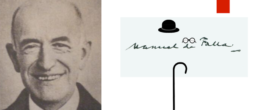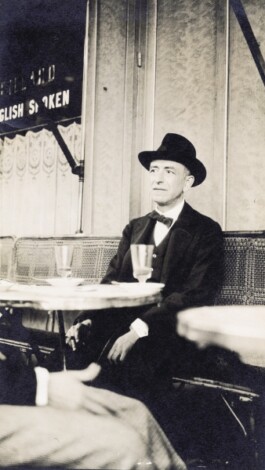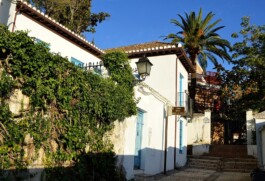


November 23, 2022
Each week, discover one of the members of the Network of Houses and Museums of European Musicians. These places link the past, present and future, they honor a tangible and intangible heritage and fulfill an essential cultural purpose in Europe. This week, we bring you to Granada in Spain to discover the Foundation and the archives dedicated to the great composer Manuel de Falla.

He is one of the greatest Spanish musical figures: Manuel María de los Dolores Falla y Matheu, known as Manuel de Falla (from 1899), was born on 23 November 1876 in Cadiz, Andalusia. A precocious talent, he began studying the piano at the age of eight and won a prize after studying at the Royal Conservatory of Madrid between 1896 and 1898. Between 1904 and 1905, he composed the lyrical drama La Vida breve. It was this opera that marked the beginning of Manuel de Falla's fame. From 1908 to 1914 he lived in Paris where he completed his Four Spanish Pieces.

Manuel de Falla at a Parisian terrace (Credits Fundación y Archivos Manuel de Falla)
Manuel de Falla - Four Spanish Pieces (1908)
Manuel de Falla: Siete Canciones Populares Españolas (1914) Teresa Berganza & Narciso Yepes, guitar. The late Teresa Berganza, one of the Centre Européen de Musique's earliest supporters and president of its Honorary Committee, was one of the great interpreters of the brilliant composer.
In the heart of the City of Light, the Spanish composer met Claude Debussy and Maurice Ravel, among others, and retained their impressionist influence. He also met his compatriot Isaac Albéniz. His long stay in Paris was above all an opportunity for him to become aware of his particularities and his Iberian identity.
From 1921 onwards, he lived in Granada, where he organised a Cante jondo competition in June 1922 in conjunction with Federico García Lorca. His house, on the edge of the Alhambra hill, is now the Manuel de Falla house-museum (see below). In 1926, at the request of the harpsichordist Wanda Landowska, Manuel de Falla wrote The Harpsichord Concerto. This work reveals a certain stylistic kinship with Domenico Scarlatti, who had lived in Spain for many years. In December 1927 he paid tribute to Domenico Scarlatti, performing 14 of his sonatas at the Ateneo de Granada. In 1931, Manuel de Falla became a member of the new National Music Council set up the same year. The tragedy of the Spanish Civil War (1936-1939) forced him to emigrate to Argentina and settle in Córdoba, where he died on 14 November 1946. During his last years, he kept his nostalgia for Spain in his body and mind. His remains were transferred to Spain and he was buried in the crypt of the cathedral of his native city, Cadiz, on 9 January 1947.

One of the last photos of Manuel de Falla taken in 1946, the year of his death (Credits Fundación y Archivos Manuel de Falla)
Manuel de Falla leaves Granada for Argentina shortly after the end of the Civil War, in the autumn of 1939. His belongings and personal effects remained behind. Thanks to the help of his relatives, these belongings are kept in private locations. After Manuel de Falla's death in 1946, his brother Germán began to collect the musician's archives kept in Cadiz, as well as those brought from Argentina by the composer's sister, María del Carmen. In 1961, the entire archive was recovered and transferred to Madrid. In 1962, under the responsibility of Isabel de Falla, the base of the current archive was established in Madrid and steps were taken for its definitive installation in Granada.

Manuel de Falla's house in Granada next to the Alhambra
In 1965, the house where Manuel de Falla lived was opened as a museum, and in 1978 the Manuel de Falla Auditorium was inaugurated, where it was planned to install the archives. A decisive step was taken in 1988 with the creation of the Manuel de Falla Foundation and Archive, which agreed to offer the city its entire documentary collection. This important institutional agreement was extended with the incorporation of the Ministry of Culture and Sports, the Consejería de Cultura y Patrimonio of the Junta de Andalucía and the University of Granada. In March 1991, the Manuel de Falla Archive opened its doors in the city where the composer had chosen to live before the Civil War, a fitting return.
For more information, visit the website of the Manuel de Falla Foundation
November 23, 2022
Each week, discover one of the members of the Network of Houses and Museums of European Musicians. These places link the past, present and future, they honor a tangible and intangible heritage and fulfill an essential cultural purpose in Europe. This week, we bring you to Granada in Spain to discover the Foundation and the archives dedicated to the great composer Manuel de Falla.

He is one of the greatest Spanish musical figures: Manuel María de los Dolores Falla y Matheu, known as Manuel de Falla (from 1899), was born on 23 November 1876 in Cadiz, Andalusia. A precocious talent, he began studying the piano at the age of eight and won a prize after studying at the Royal Conservatory of Madrid between 1896 and 1898. Between 1904 and 1905, he composed the lyrical drama La Vida breve. It was this opera that marked the beginning of Manuel de Falla's fame. From 1908 to 1914 he lived in Paris where he completed his Four Spanish Pieces.

Manuel de Falla at a Parisian terrace (Credits Fundación y Archivos Manuel de Falla)
Manuel de Falla - Four Spanish Pieces (1908)
Manuel de Falla: Siete Canciones Populares Españolas (1914) Teresa Berganza & Narciso Yepes, guitar. The late Teresa Berganza, one of the Centre Européen de Musique's earliest supporters and president of its Honorary Committee, was one of the great interpreters of the brilliant composer.
In the heart of the City of Light, the Spanish composer met Claude Debussy and Maurice Ravel, among others, and retained their impressionist influence. He also met his compatriot Isaac Albéniz. His long stay in Paris was above all an opportunity for him to become aware of his particularities and his Iberian identity.
From 1921 onwards, he lived in Granada, where he organised a Cante jondo competition in June 1922 in conjunction with Federico García Lorca. His house, on the edge of the Alhambra hill, is now the Manuel de Falla house-museum (see below). In 1926, at the request of the harpsichordist Wanda Landowska, Manuel de Falla wrote The Harpsichord Concerto. This work reveals a certain stylistic kinship with Domenico Scarlatti, who had lived in Spain for many years. In December 1927 he paid tribute to Domenico Scarlatti, performing 14 of his sonatas at the Ateneo de Granada. In 1931, Manuel de Falla became a member of the new National Music Council set up the same year. The tragedy of the Spanish Civil War (1936-1939) forced him to emigrate to Argentina and settle in Córdoba, where he died on 14 November 1946. During his last years, he kept his nostalgia for Spain in his body and mind. His remains were transferred to Spain and he was buried in the crypt of the cathedral of his native city, Cadiz, on 9 January 1947.

One of the last photos of Manuel de Falla taken in 1946, the year of his death (Credits Fundación y Archivos Manuel de Falla)
Manuel de Falla leaves Granada for Argentina shortly after the end of the Civil War, in the autumn of 1939. His belongings and personal effects remained behind. Thanks to the help of his relatives, these belongings are kept in private locations. After Manuel de Falla's death in 1946, his brother Germán began to collect the musician's archives kept in Cadiz, as well as those brought from Argentina by the composer's sister, María del Carmen. In 1961, the entire archive was recovered and transferred to Madrid. In 1962, under the responsibility of Isabel de Falla, the base of the current archive was established in Madrid and steps were taken for its definitive installation in Granada.

Manuel de Falla's house in Granada next to the Alhambra
In 1965, the house where Manuel de Falla lived was opened as a museum, and in 1978 the Manuel de Falla Auditorium was inaugurated, where it was planned to install the archives. A decisive step was taken in 1988 with the creation of the Manuel de Falla Foundation and Archive, which agreed to offer the city its entire documentary collection. This important institutional agreement was extended with the incorporation of the Ministry of Culture and Sports, the Consejería de Cultura y Patrimonio of the Junta de Andalucía and the University of Granada. In March 1991, the Manuel de Falla Archive opened its doors in the city where the composer had chosen to live before the Civil War, a fitting return.
For more information, visit the website of the Manuel de Falla Foundation


Playlist



